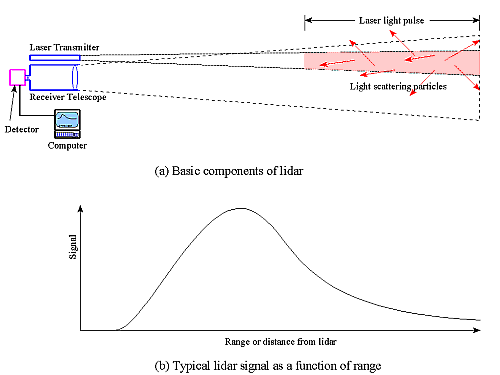Atmospheric Remote Sensing: Instruments
LIDAR
LIDAR is an acronym for LIght Detection And Ranging.
Light is scattered and attenuated by molecules, aerosols (dust), and cloud (water or ice) particles in the atmosphere. The sky can be clear and blue or hazy and white. Red sunsets are a beautiful manifestation of the scattering and attenuation of sunlight. Clouds can appear white, grey, or dark depending on conditions. Light scattering and attenuation can be used to investigate the atmosphere using a remote-sensing instrument called a lidar.

A lidar system uses laser pulses to measure atmospheric constituents such as aerosol particles, ice crystals, water vapor, or trace gases (e.g. ozone). Profiles of these atmospheric components as a function of altitude or location are necessary for weather forecasting, climate modeling, and environmental monitoring.
A lidar transmits short pulses of laser light into the atmosphere. The laser beam loses light to scattering as it travels. At each range, some of the light is backscattered into a detector, figure (a). Because the light takes longer to return from the more distant ranges, the time delay of the return pulses can be converted to the corresponding distance between the atmospheric scatterer and the lidar. The end result is a profile of atmospheric scattering versus distance, figure (b). Analysis of this signal can yield information about the distribution of aerosols in the atmosphere. The amount of backscatter indicates the density of the scatters. This can be used to measure cloud base height or track plumes of pollution.
Other properties of the atmosphere can also be deduced from the lidar return signals. A frequency shift in the light because of the Doppler effect permits measurement of wind speeds. By detecting the amount of depolarization, one can discriminate between liquid droplets and nonspherical ice particles. Differential Absorption Lidar (DIAL) uses absorption, as evidenced by reduced backscatter from greater distances, to measure the concentration of atmospheric gases. A Raman lidar detects particular atmospheric components (such as water vapor) by measuring the wavelength-shifted return from selected molecules.